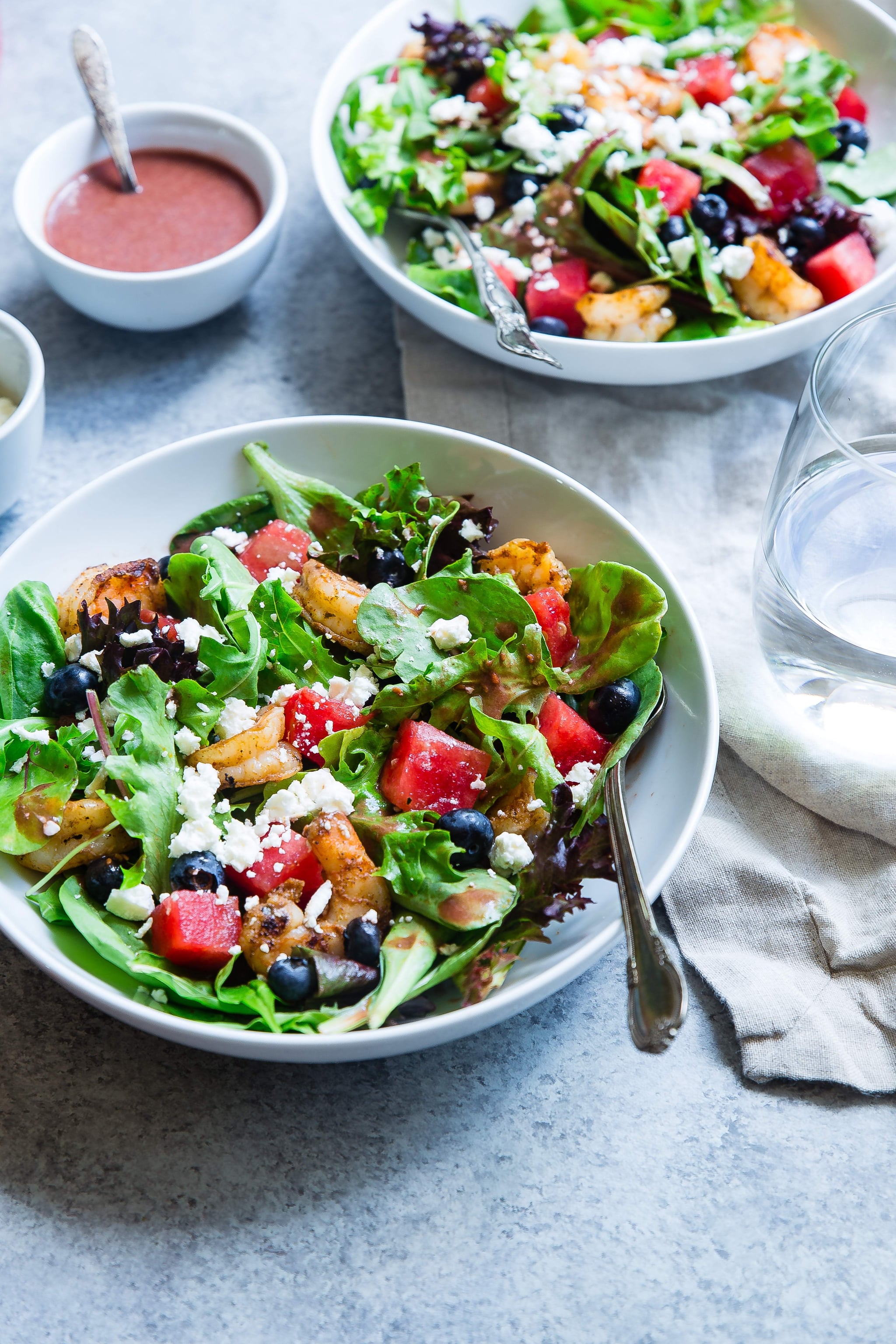
Our go-to lunch when we are watching what we eat is a salad [1], but between the toppings and the dressing, that salad may not end up as healthy as we hope for it to be. Choosing the right ingredients and eating the right serving size of each can go a long way toward keeping our healthy intentions.
The key to keeping salad healthy is to keep an eye on what we are putting in it, starting with healthier dressings. First of all, avoid dressings that say "fat-free" or "creamy" on the label. "Fat-free usually means they compensated for the lack of fat by adding a ton of sugar so that consumers aren't able to taste the lack of fat," said Charlotte Martin, MS, RDN, CSOWM, CPT certified specialist in obesity and weight management. Plus, healthy fat in salad dressing is a good thing!
"Fat helps us absorb the fat-soluble vitamins (vitamins A, D, E, and K) that can be found in the produce and proteins in our salad," Martin said. The word "creamy" usually indicates an unnecessarily high amount of fat, usually in the form of saturated fats.
Go for a short and sweet ingredient list. "I read the ingredient list to make sure there aren't any artificial colors, ingredients, and preservatives, as well as ingredients that aren't easily pronounceable," Martin said. That includes less than two grams of sugar per serving. "Many salad dressings will have a little bit of sugar, and that's OK. But I'd rather save the sugar for a salad topper like fresh sliced fruit or unsweetened dried fruit."
To put this into perspective, one teaspoon of sugar has four grams of sugar. So half a teaspoon sugar max per serving of salad dressing (which is typically one to two tablespoons) is plenty!
Of course, keep calories in mind as well. "Some salad dressings can run upwards of 100 calories per one tablespoon serving, which is just too much for such a small serving size. Since I'd rather spend my calories on more salad toppers, I look for dressings with more bang for my calorie buck," Martin said. "I usually won't buy a dressing with more than 150 calories per two-tablespoon serving. However, I usually stick to around 100 calories per two-tablespoon serving because there are so many options available that fit this criteria!"
Check out these prime options next time you're at the supermarket.
- Primal Kitchen Honey Mustard Vinaigrette with Avocado Oil: "Honey mustard vinaigrettes are typically very high in sugar!" Martin said. "This dressing only contains two grams of sugar per two-tablespoon serving. Also, all of the sugar is coming from honey, and not refined sugar sources." Serving size: 2 tbsp., Cals: 100, Total fat: 10g, Saturated fat: 1.5g, Carbs: 3g, Sugar: 2g
- Bolthouse Farms Organic Avocado Ranch: "I like Bolthouse's dressings because they are yogurt based and are a lower-calorie option (without sacrificing on flavor)," Martin said. There's only one gram of sugar, and it's not coming from added sugars. Serving size: 2 tbsp., Cals: 50, Total fat: 4.5g, Saturated fat: 1g, Carbs: 2g, Sugar: 1g
- Annie's Naturals Woodstock Dressing: "This dressing has a tomato and tahini base, giving it a nutty yet tangy flavor not commonly found in salad dressings," Martin said. It also has no added sugar. Serving size: 2 tbsp., Cals: 100, Total fat: 10g, Saturated fat: 1g, Carbs: 2g, Sugar: 0g
- Marzetti Simply Dressed Avocado Ranch Dressing: "Marzetti makes quite a few healthy dressings, but this one tops the list thanks to its higher-than-normal healthy fats, which it gets from canola oil (another high oleic oil), buttermilk, avocado, and egg yolk," said Claire Martin, RD, a registered dietitian. It has 120 calories per serving of two tablespoons, but thanks to its rich, wholesome ingredients, it does not tasty "healthy" but has a great creamy luscious texture and flavor. It also offers 430 mg of omega-3 fats per serving. Serving size: 2 tbsp. Cals: 120, Total fat: 13g, Cholesterol: 5mg, Sugar: 1g.
- Bragg Organic Vinaigrette: "This vinaigrette is made by the same company that makes Bragg apple cider, which is also an ingredient in this low-calorie dressing. Its base is Bragg organic extra virgin olive oil, which is a high oleic oil and so is high in unsaturated fat and low in saturated fat," Claire Martin said. "This vinaigrette also contains Bragg liquid aminos, honey, garlic, onion, and black pepper (all organic), with only two grams of sugar per serving size of two tablespoons." This dressing is a total of 90 calories per serving and a very healthy way to add some flavor to a salad. Serving size: 2 tbsp., Cals: 90, Total fat: 9g, Cholesterol: 0, Sodium: 60 mg, Sugar: 2g.